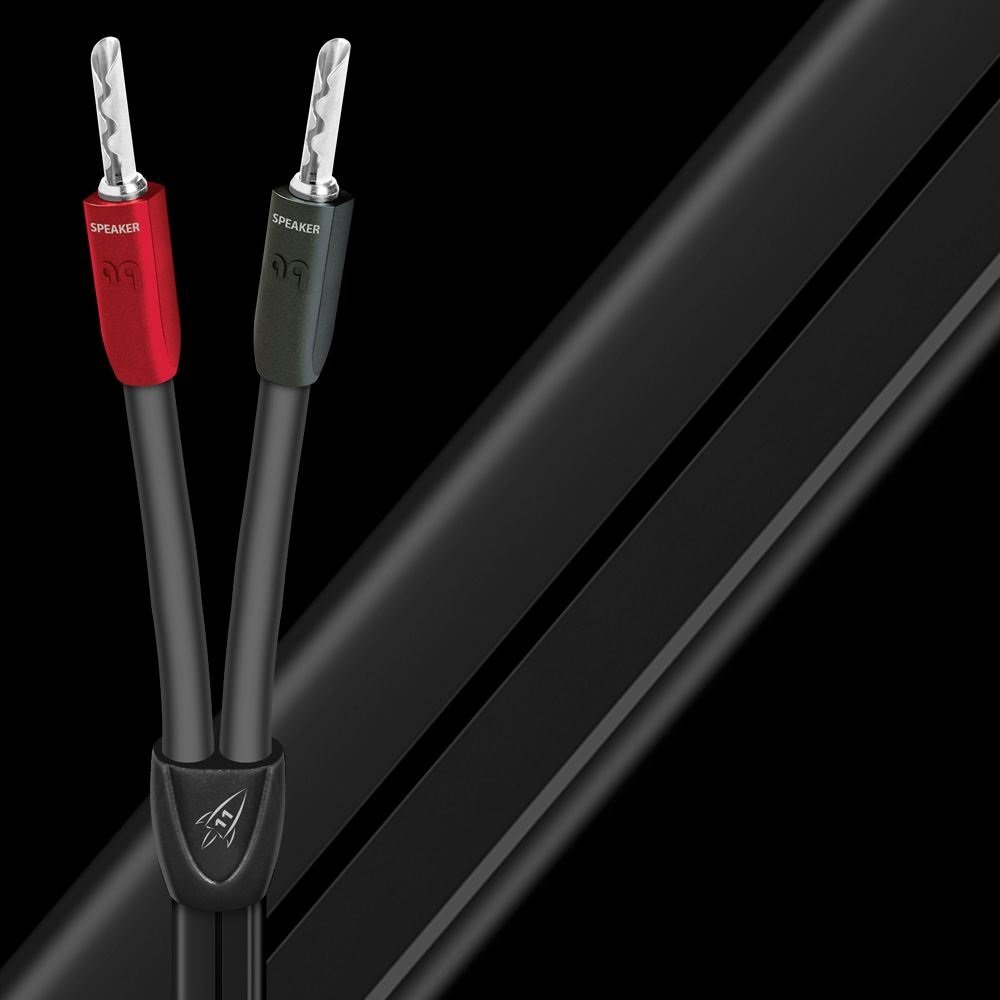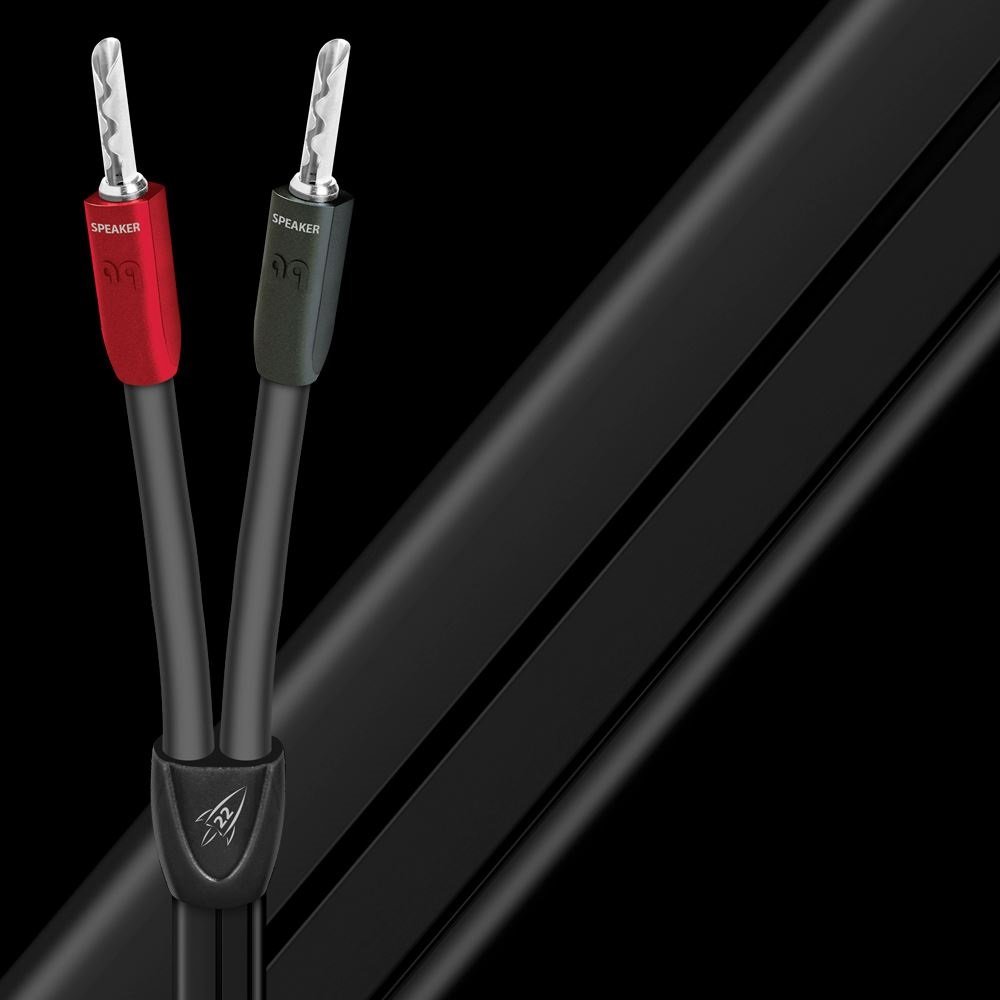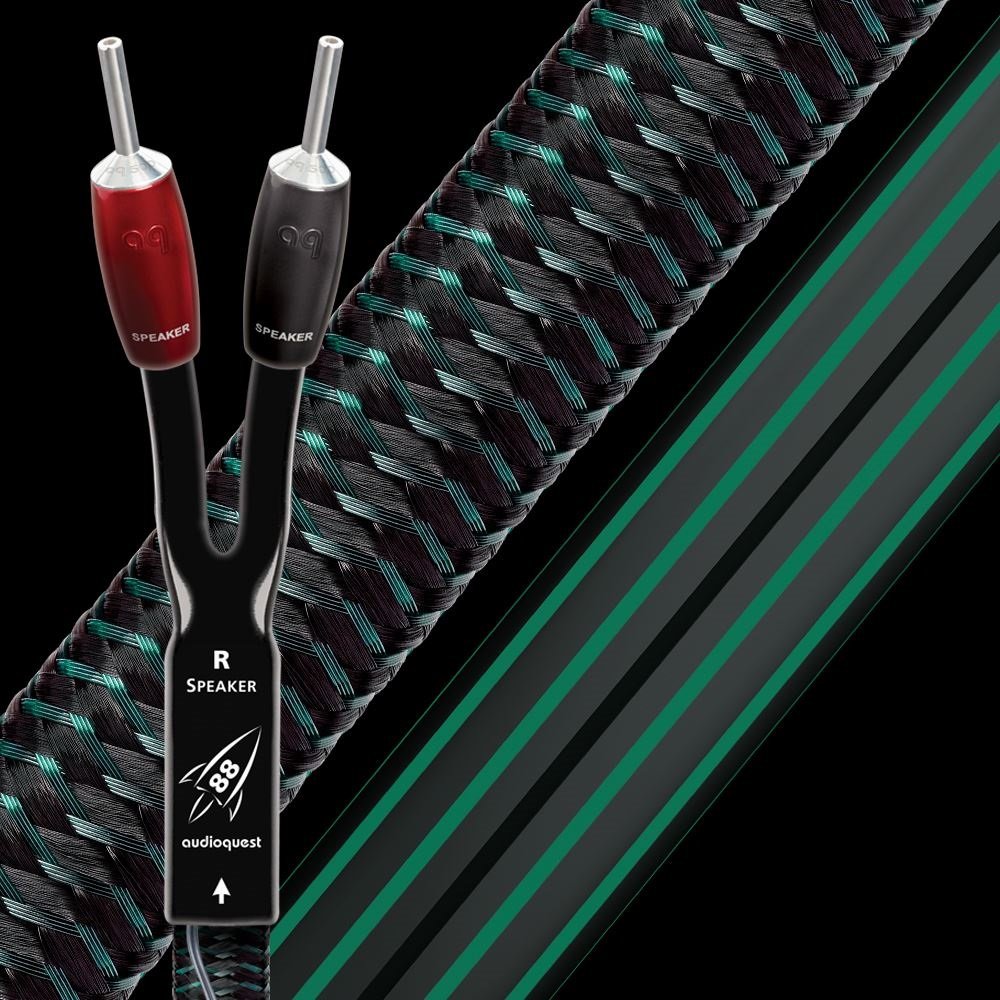Audioquest Rocket Series
Variable lengths, connectors and pricing
Description
Rocket 11
SEMI-SOLID CONCENTRIC LONG-GRAIN COPPER (LGC) CONDUCTORS
In a conventional multi-strand cable, distortion caused by electrical and magnetic strand interaction is compounded as each strand changes position within the bundle. In an AQ Semi-Solid Concentric cable, strands within the bundle maintain their fixed relationships, significantly reducing distortion. Long-Grain Copper (LGC) allows a smoother and clearer sound than cables using regular OFHC (Oxygen-Free High-Conductivity) copper. LGC has fewer oxides within the conducting material, less impurities, less grain boundaries, and definitively better performance.
DOUBLE LOW-INDUCTANCE TWISTED PAIR GEOMETRY
A typical speaker cable with parallel conductors has fairly high inductance, smearing energy across time, which results in sound that is dull and unfocused. In Rocket 11, the two conductors in each half of the cable are twisted around one another, providing lower inductance, greater clarity, and superior bass-to-treble frequency extension
IDEAL FOR FULL-RANGE OR SINGLE-BIWIRE CONFIGURATIONS
Use Rocket 11 as a full-range cable, with red (+) and black (-) conductors grouped together, or, when the speakers provide separate bass and treble inputs, further optimize system performance by biwiring.
Rocket 22
LONG-GRAIN COPPER/PERFECT-SURFACE COPPER CONDUCTORS
Rocket 22 uses a carefully finessed blend of Long-Grain Copper (LGC) and high-purity Perfect-Surface Copper (PSC). LGC has fewer impurities and fewer internal grain junctions than standard OFHC copper, while the even smoother, purer surface of PSC further eliminates harshness and improves clarity. All AudioQuest conductors are direction-controlled for optimum noise dissipation.
SEMI-SOLID CONCENTRIC CONDUCTORS
Semi-Solid Concentric conductors are a far-superior performance alternative to typical stranded conductors. Semi-Solid Concentric conductors use fewer, larger strands that do not change position down the length of the cable. The strands maintain their fixed, rigid relationships, reducing distortion, improving resolution and dynamics, and greatly minimizing harshness and confusion due to strand interaction.
IDEAL FOR FULL-RANGE OR SINGLE-BIWIRE CONFIGURATIONS
Use Rocket 11 as a full-range cable, with red (+) and black (-) conductors grouped together, or, when the speakers provide separate bass and treble inputs, further optimize system performance by biwiring.
DOUBLE LOW-INDUCTANCE TWISTED PAIR GEOMETRY
A typical speaker cable with parallel conductors has fairly high inductance, smearing energy across time, which results in sound that is dull and unfocused. In Rocket 11, the two conductors in each half of the cable are twisted around one another, providing lower inductance, greater clarity, and superior bass-to-treble frequency extension
Rocket 33
DOUBLE STAR-QUAD GEOMETRY
The relationship between conductors defines a cable’s most basic electrical values (capacitance and inductance). However, even when those variables are kept in reasonably neutral balance, the particular geometric relationship between conductors greatly affects the sound. Star-Quad geometry is not only vastly superior to conductors run in parallel, but also to the same conductors as two twisted pairs.
SOLID PERFECT-SURFACE COPPER (PSC)/LONG-GRAIN COPPER (LGC) CONDUCTORS
This cable uses a carefully finessed combination of Long-Grain Copper (LGC) and extremely high-purity Perfect-Surface Copper (PSC). LGC has fewer oxides within the conducting material, less impurities, less grain boundaries and definitively better performance. The astonishingly smooth and pure PSC further eliminates harshness and greatly increases clarity.
CARBON-BASED NOISE- AND CROSSTALK-DISSIPATION SYSTEM
This cable’s negative conductors are covered with partially conductive Carbon-Loaded Polyethylene. This remarkable material reduces radio-frequency garbage being fed back into the amplifier. The sonic benefit is exactly the same reduction in “hash” and improved dimensionality that comes whenever RF interference is reduced in an audio circuit. In addition, a carbon layer damps interaction between positive and negative conductors, and an external Carbon-Based Noise-Dissipation System reduces external interference.
FOAMED-POLYETHYLENE INSULATION (FOR ALL POSITIVE CONDUCTORS)
Any solid material adjacent to a conductor is actually part of an imperfect circuit. Wire insulation and circuit board materials all absorb energy. Some of this energy is stored and then released as distortion. This cable, however, uses air-filled Foamed-Polyethylene Insulation on both conductors. Because air absorbs next to no energy and Polyethylene is low-loss and has a benign distortion profile, Foamed-PE, with its high air content, causes much less of the out-of-focus effect common to other materials.
CHOICE OF SUREGRIP SPADE OR SUREGRIP 300 BFA/BANANA (GOLD OR SILVER) CONNECTORS
Rocket 44
SOLID PERFECT-SURFACE COPPER+ (PSC+)/PERFECT-SURFACE COPPER (PSC) CONDUCTORS
This cable uses a carefully finessed combination of Perfect-Surface Copper (PSC) and extremely high purity Perfect-Surface Copper+ (PSC+) conductors. The astonishingly smooth and pure Perfect-Surface eliminates harshness and greatly increases clarity compared to OFHC, OCC, 8N and other coppers. Extremely high-purity PSC+ further minimizes distortion caused by grain boundaries, which exist within any metal conductor.
DOUBLE STAR-QUAD GEOMETRY
The relationship between conductors defines a cable’s most basic electrical values (capacitance and inductance). However, even when those variables are kept in reasonably neutral balance, the particular geometric relationship between conductors greatly affects the sound. Star-Quad geometry is not only vastly superior to conductors run in parallel, but also to the same conductors as two twisted pairs.
CARBON-BASED NOISE- AND CROSSTALK-DISSIPATION SYSTEM
This cable’s negative conductors are covered with partially conductive Carbon-Loaded Polyethylene. This remarkable material reduces radio-frequency garbage being fed back into the amplifier. The sonic benefit is exactly the same reduction in “hash” and improved dimensionality that comes whenever RF interference is reduced in an audio circuit. In addition, a carbon layer damps interaction between positive and negative conductors, and an external Carbon-Based Noise-Dissipation System reduces external interference.
FOAMED-POLYETHYLENE INSULATION (FOR ALL POSITIVE CONDUCTORS)
Any solid material adjacent to a conductor is actually part of an imperfect circuit. Wire insulation and circuit board materials all absorb energy. Some of this energy is stored and then released as distortion. This cable, however, uses air-filled Foamed-Polyethylene Insulation on both conductors. Because air absorbs next to no energy and Polyethylene is low-loss and has a benign distortion profile, Foamed-PE, with its high air content, causes much less of the out-of-focus effect common to other materials.
CHOICE OF 500 SERIES MULTI-SPADE OR BANANA (GOLD OR SILVER) CONNECTORS
Rocket 88
SOLID PERFECT-SURFACE COPPER+ (PSC+) CONDUCTORS
Solid conductors prevent both electrical and magnetic interaction strand-to-strand interaction, major sources of distortion. Surface quality is critical because a conductor can be considered as a rail-guide for both the fields within a conductor, and for the magnetic fields that extend outside the conductor. The astonishingly smooth and pure surface of all AudioQuests’s Perfect-Surface metals nearly eliminates harshness and greatly increases clarity compared to lesser materials. Extremely high-purity Perfect-Surface Copper+ further minimizes distortion caused by grain boundaries, which exist within any metal conductor, nearly eliminating harshness and greatly increasing clarity compared to OFHC, OCC, 8N and other coppers.
DOUBLE STAR-QUAD GEOMETRY
The relationship between conductors defines a cable’s most basic electrical values (capacitance and inductance). However, even when those variables are kept in reasonably neutral balance, the particular geometric relationship between conductors greatly affects the sound. Star-Quad geometry is not only vastly superior to conductors run in parallel, but also to the same conductors as two twisted pairs.
CARBON-BASED NOISE- AND CROSSTALK-DISSIPATION SYSTEM
This cable’s negative conductors are covered with partially conductive Carbon-Loaded Polyethylene. This remarkable material reduces radio-frequency garbage being fed back into the amplifier. The sonic benefit is exactly the same reduction in “hash” and improved dimensionality that comes whenever RF interference is reduced in an audio circuit. In addition, a carbon layer damps interaction between positive and negative conductors, and an external Carbon-Based Noise-Dissipation System reduces external interference.
FOAMED-POLYETHYLENE INSULATION (FOR ALL POSITIVE CONDUCTORS)
Any solid material adjacent to a conductor is actually part of an imperfect circuit. Wire insulation and circuit board materials all absorb energy. Some of this energy is stored and then released as distortion. This cable, however, uses air-filled Foamed-Polyethylene Insulation on both conductors. Because air absorbs next to no energy and Polyethylene is low-loss and has a benign distortion profile, Foamed-PE, with its high air content, causes much less of the out-of-focus effect common to other materials.
CHOICE OF 500 SERIES MULTI-SPADE OR BANANA (GOLD OR SILVER) CONNECTORS
DIELECTRIC-BIAS SYSTEM WITH RADIO FREQUENCY TRAP
All insulation between two or more conductors is also a dielectric whose properties will affect the integrity of the signal. When the dielectric is unbiased, dielectric-involvement (absorption and non-linear release of energy) causes different amounts of time delay (phase shift) for different frequencies and energy levels, which is a real problem for very time-sensitive multi-octave audio. The inclusion of an RF Trap (developed for AudioQuest’s Niagara Series of power products), ensures that radio-frequency noise will not be induced into the signal conductors from the DBS field elements. (DBS, US Pat #s 7,126,055 & 7,872,195 B1)











